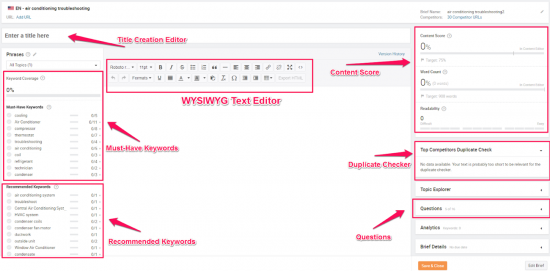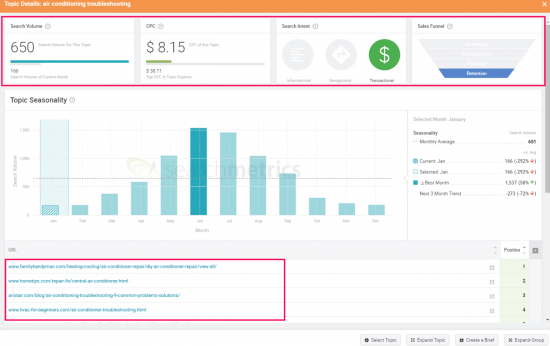Any business owner or marketing director knows how difficult it is to get found online. Often marketing teams can become buried under the weight of planning, creating, and optimizing content for their site. Marketing teams often are unable to produce great content efficiently because they rely on disconnected tools and disjointed processes. As groups grow from smaller teams that work fine through these inefficiencies, keeping those same tools and processes hinders the ability to serve customers and grow the business.
In this installment of Memo to the Modern Marketer guest author Chris Giarratana takes the Searchmetrics Content Experience for a spin in his quest to create and optimize great content.

Understanding User Intent and Optimization
Modern marketers every quarter must make decisions on how much to invest in earned media, using staffing, tools and processes to deliver a return on investment that is not nearly as easy to understand as investments in paid and brand. In earned media, the hits can keep coming if you create the right formula for being found online and meeting the needs of the user searching for your product. If you miss, you’re out of the game – sometimes forever.
Let’s take a look at how we can use the Searchmetrics Content Experience (SCE) to understand what our customers want and how to optimize that content to drive qualified traffic and boost conversions on our site.
What Makes Content Amazing?
Not all content is created equal because not all content provides the same value to you or your audience. In fact, the only type of content that is valuable is when that content is optimized to get found in search engines, aligns with your business goals, and answers specific questions that your customers are looking for.
Here are some elements that make content valuable and relevant to your audience:
- Original content crafted for the needs of your customers.
- Actionable content to help your audience solve problems or needs.
- Provide answers to specific questions your audience asks.
- Optimized to be found in search engines like Google and Bing.
- Engaging for your audience (usability, formatting, etc.).
- Short and pointed content because your audience doesn’t have time to read fluff.
- Includes images and other media to help communicate your message.
- Relevant content that is not outdated or off-topic.
- Aligns with your business goals. You are paying for content production, so you should be fulfilling a specific business need with each piece of content.
Making content is neither cheap nor easy. This is why many companies look to copywriting services to help them create great content for their company. As the competition continues to grow and search engines change their algorithms, your team needs to be ready and agile to adjust your marketing strategy based on your market.
Evolving Content Audience
Gone are the days when creating a 500-word blog post once a month or publishing a low-quality video was enough to drive qualified traffic to your site. As technology has evolved, the standards that your customer expects are changing too.
In many cases, poor content will drive your customers away from your website and prevent a sale. At the same time, if your content is not optimized to get found by Google and your target audience, then your site won’t have a chance to engage with your customers.
This is why your business needs to use every competitive advantage it can to thrive and outpace your competition.
At a certain point, every marketing team reaches a size where the tools and processes that were used in the past are not practical or efficient. Many small-sized organizations can get away with bootlegging the content creation process. This is OK because that makes financial and logistical sense. However, in medium and large companies it can become a hindrance to rely on the same online marketing tools for small business to make content that was used in other stages of the company.
This is why Searchmetrics offers powerful tools to marketing teams who don’t want to waste time jumping between tools and optimizing content based on methods that are not efficient for growth.
How To Make Awesome Content & Save Time
In a previous post, I looked at how to discover user intent and take the first steps to develop great content for an air conditioner repair company.
In that step-by-step guide, I walked through how to understand the customer journey, uncover user intent, identify seasonality for our content ideas.
1. Review Previous Research & Identify Topic
At the end of the post, I created a spreadsheet that outlined all the variables and highlighted a few ideas to drive our content marketing initiatives. Here are the final results and the content ideas that came up for consideration for content production.
To show how our air conditioner repair company can use the Searchmetrics Content Experience to develop unique content, let’s look at content centering on air conditioning troubleshooting.
This content will help establish the business as a thought leader. Material about how to troubleshoot an air conditioning issue can help us drive qualified traffic to our site. Once readers see they need professional repair services, having great content that can be found easily could easily translate into being the first company they look to hire.
2. Find Content Keywords
The first thing that we need to do is open up the brief I made last time in the Searchmetrics Content Experience. Once opened, we can hover over all the results and find the desired topic – in this case, we want to choose air conditioner troubleshooting.
After we select the topic, we just need to click on Topic Details to expand the keyword information.
3. Expand The Topic, Review Intent & Competition
Now that we have expanded details about air conditioning troubleshooting, we can look at some critical information to help direct our content production, including:
- Search Volume: The higher the Search Volume, the more demand there is for our keyword. We should try to balance keywords with Search Volume and relevance, and since we are using a long tail keyword, a high Search Volume is an excellent choice.
- Search Intent: Since we want to develop content that will drive direct sales, choosing a keyword with Transactional Intent is the best way to proceed.
- Sales Funnel: As one of our goals, we want our content to help us retain our customer base. People looking for troubleshooting tips are likely ready to buy, and we can keep the sales cycle open by creating content with Retention.
- Competitor URLs: The final piece of information that Searchmetrics provides on this screen is a list of our top competitors. We should look at this list to understand the type of content that is already out there and find opportunities to improve content based on what our competition is currently promoting.
Since we are happy with this keyword and excited to start crafting great content, we can click out of the screen to start writing optimized content in the Content Editor.
4. Plan, Write & Optimize Our Content In No Time
Creating excellent content can take a lot of time, and if your team needs to keep up with the needs of your customers, then you likely need to produce lots of content. Not only does this content need to be relevant for your audience, but it also has to be optimized for search engines if you want your information to get found.
Once we enter the Content Editor screen, we are presented with lots of information.

Let’s take a quick overview of each section, and how they help us create content.
- Title Creation: The title of our content is one of the most important on-page factors for SEO because it is the first thing that Google and our readers see. We should optimize our title based on the topic, scope, and purpose.
- Must-Have Keywords: If we want our content to rank online, then we need to include specific keywords. In the past, marketing teams would need to leverage several tools and go through extensive processes to find keywords and document their use. Searchmetrics makes it easy to track which keywords we are using, so we can optimize the content accordingly.
- Recommended Keywords: Google needs additional information to understand our content, so we should use LSI keywords. Searchmetrics makes finding these keywords easy, and displays the keywords and volume that we should use right in the editor.
- Content Score: This section will help inform us about how well our content is optimized based on the robust Searchmetrics database. With this section, we can focus on our content and less on guessing how optimized our content is as we are writing.
- Duplicate Checker: Nothing will kill our credibility or online presence faster than publishing duplicate content. We can prevent using duplicate content by keeping an eye on the Duplicate Checker section where Searchmetrics will show us if we include duplicate content.
- Featured Questions: Google search queries are based on questions that people ask. Since we want to rank in Google and address the needs of our audience, we should include items in our content. This section makes it easy to find specific questions to add to our content.
- Convenient WYSIWYG Text Editor: Nothing is worse than spending time on formatting and not focusing on our content. This easy to use text editor makes it a breeze to write content just like we were using Word or another word processor.
With this information, we can begin writing a great article. After about 20 minutes, I created a rough draft that is optimized based on all the suggestions.
The content is optimized with a good set of keywords, and our footprint is wide enough to get found by Google. Plus, our article is unique and is long enough to meet the needs of our customers. While there are some areas that we can improve, it is impressive just how quickly we can produce high-quality content with all the tools we need to write and optimize in a single location.
This means that I can focus on writing and make great content instead of thinking about keywords, questions, and how well my content is optimized. The upshot is anyone on my team can produce content faster (and have more fun doing it). It also means that we are more confident in the final product.
More Time For Customers
While it is a lot of fun to make content for our business, the bottom line is that our customers matter more than our content. We need to produce great content that engages our customers and gets found by Google if we want to survive in a competitive market.
Content Editor in the Searchmetrics Suite allows us to think about the content we are producing and less about all the intricate details that go into making our content amazing. There’s loads of other tools out there that can help us accomplish the same thing. But, as I noted earlier, they’re disconnected from each other. That makes the process more of a hassle and can make the end result less impactful and inefficient.





